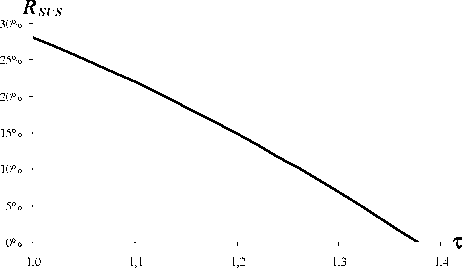loss the final question arises which level of transfer may guarantee a real wage
relation of unity. At the sustain point the necessary level of transfers,RS U S,
can be calulated by setting (20) to one and solving for RSUS to get:
RSUS = 1 -
2(1 - TI)(1 - ΘPγ)
(21)
1 - ΘΘ* + TI [ΘΘ*γ - 1 + ΘPy(1 - γ)]
Substituting now the optimal tariffs of (15) yields the necessary amount
of transfers to guarantee a long-run income convergence at L=0. Figure 6
presents this result with the simple outcome that transfers must increase
continuously as integration proceeds and trade costs decrease. Furthermore,
the volume of transfers is considerable higher than the level which has to be
paid to compensate only the welfare loss.

Parameters: γ = 0.5, σ = 4
Figure 6: Necessary transfers (in % of Y ) to guarantee convergence for L=0
8 Conclusion
This paper has shown that within an agglomeration model countries or re-
gions face an incentive for taxing the competitive sector and protecting do-
mestic monopolistic industries by corresponding tariffs. Two cases have been
compared, policies with and without cooperation, while the goal is maximiz-
ing aggregated welfare in the former case and regional welfare in the latter
case. The main result is that under cooperation especially less developed
18
More intriguing information
1. Handling the measurement error problem by means of panel data: Moment methods applied on firm data2. CAN CREDIT DEFAULT SWAPS PREDICT FINANCIAL CRISES? EMPIRICAL STUDY ON EMERGING MARKETS
3. Conditions for learning: partnerships for engaging secondary pupils with contemporary art.
4. ISSUES AND PROBLEMS OF IMMEDIATE CONCERN
5. Transgression et Contestation Dans Ie conte diderotien. Pierre Hartmann Strasbourg
6. For Whom is MAI? A theoretical Perspective on Multilateral Agreements on Investments
7. The name is absent
8. Prizes and Patents: Using Market Signals to Provide Incentives for Innovations
9. The name is absent
10. The Role of Evidence in Establishing Trust in Repositories